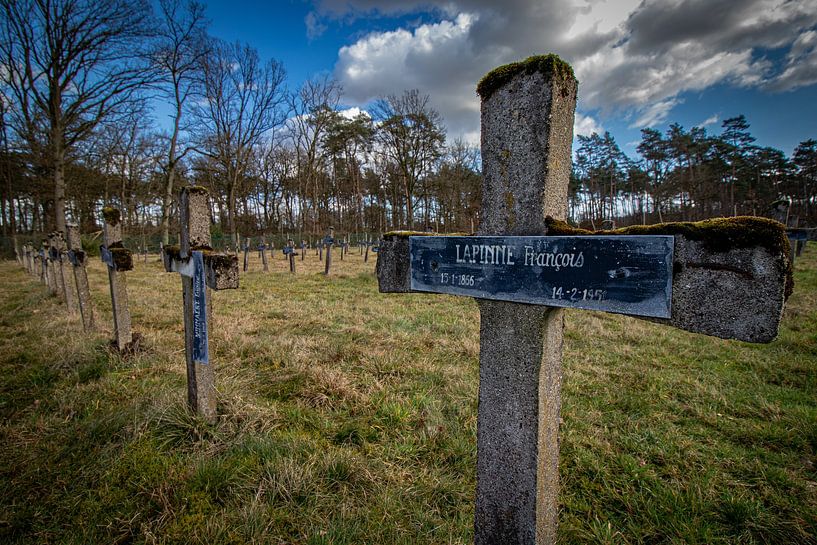Buy the photo Cemetery Psychiatric patients by Eddy Smets on canvas, ArtFrame, poster and wallpaper, printed on demand in high quality.
About "Cemetery Psychiatric patients"
by Eddy Smets
About the artwork
In the cemetery are rows of simple, anonymous crosses, each bearing a name, but otherwise without any personal identification. In their uniformity, the graves of psychiatric patients seem a sombre symbol of oblivion. The crosses are bare, without decorations or distinctive features. Their simple, almost mechanical appearance reinforces the feeling of impersonality, as if these people were not remembered as individuals, but as a mass lost in oblivion.
The atmosphere in the cemetery is lugubrious. The lack of any decoration or special attention to these graves evokes a sense of disinterest, even denial. These people were often not seen for who they were, their lives overshadowed by their illness and the stigmas that came with it. Now, in death, they are in nothing more than a series of anonymous, identical markers.
The crosses stand as silent witnesses to the lives that lay behind these souls: lives that were often lived in the shadows of society. The simple, almost clinical design of the cemetery highlights the raw reality of their neglect. These people, who may have gone unheard all their lives, also go unnoticed in death. The cemetery tells the story of a community that dismissed these souls, their dignity and identity hidden away behind the impersonal simplicity of their headstones.

About Eddy Smets
Hi, I'm an amateur photographer from Belgium. Try to take cool photos with a nice twist that I try to give to it myself... Read more…
 Germany
Germany Ordered in November 2022
Ordered in November 2022
 Netherlands
Netherlands Ordered in October 2021
Ordered in October 2021
 Netherlands
Netherlands Ordered in November 2021
Ordered in November 2021
 Netherlands
Netherlands Ordered in November 2019
Ordered in November 2019
 Germany
Germany Ordered in November 2020
Ordered in November 2020
 Germany
Germany Ordered in June 2023
Ordered in June 2023
 Netherlands
Netherlands Ordered in July 2021
Ordered in July 2021
 Germany
Germany Ordered in June 2020
Ordered in June 2020
 Germany
Germany Ordered in November 2021
Ordered in November 2021
 Germany
Germany Ordered in July 2021
Ordered in July 2021
 Germany
Germany Ordered in December 2021
Ordered in December 2021
 Germany
Germany Ordered in January 2021
Ordered in January 2021
About the material
ArtFrame™
Interchangeable Art Prints
- High-quality print
- Easily interchangeable
- Acoustic function
- Large sizes available
Discover the artworks of Eddy Smets
 Abandoned planeEddy Smets
Abandoned planeEddy Smets Abandoned planeEddy Smets
Abandoned planeEddy Smets Snow leopardEddy Smets
Snow leopardEddy Smets MariboeEddy Smets
MariboeEddy Smets Delicacies on the BarbecueEddy Smets
Delicacies on the BarbecueEddy Smets Hitting the roadEddy Smets
Hitting the roadEddy Smets Looking @ the stairsEddy Smets
Looking @ the stairsEddy Smets Vespa in the streetsEddy Smets
Vespa in the streetsEddy Smets Give me some more wineEddy Smets
Give me some more wineEddy Smets Work @ the studioEddy Smets
Work @ the studioEddy Smets Work @ the studioEddy Smets
Work @ the studioEddy Smets Walking @ the beachEddy Smets
Walking @ the beachEddy Smets Koala falling asleepEddy Smets
Koala falling asleepEddy Smets Lonely Tree at the beachEddy Smets
Lonely Tree at the beachEddy Smets Macro treeEddy Smets
Macro treeEddy Smets Inside the ChurchEddy Smets
Inside the ChurchEddy Smets Large imposing VultureEddy Smets
Large imposing VultureEddy Smets Walk @ the ParcEddy Smets
Walk @ the ParcEddy Smets @ The StationEddy Smets
@ The StationEddy Smets Looking at the cameraEddy Smets
Looking at the cameraEddy Smets













 Melancholic Elegance
Melancholic Elegance Mysterious Spheres
Mysterious Spheres Photo wallpaper
Photo wallpaper Photography
Photography









